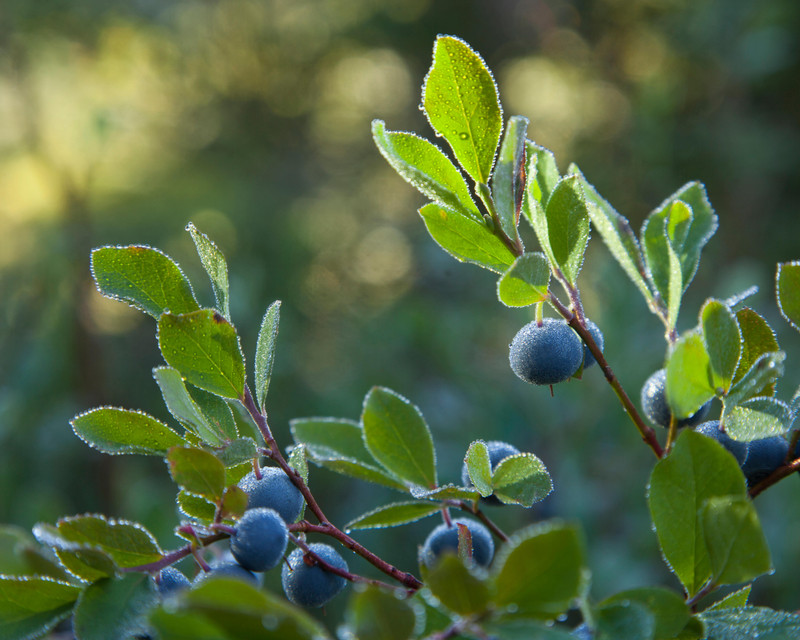Discover Our Native Huckleberries: The Best Selection in the West
At Native Foods Nursery, we’re proud to carry the largest and best selection of native Vacciniums (huckleberries) in the West. These beloved berry bushes aren’t just iconic parts of our forests—they’re also delicious, nutritious, and resilient plants to grow at home.
Below you’ll find At a Glance guides, fun facts, and a comparison table covering the species we offer.
For example, did you know that a single colony of huckleberry can live to be hundreds of years old? In fact, lingonberry stands, in paritcular, have been recorded at 8000-10000 years and still fruiting - longer than the oldest trees! Now that's a sustainable garden!
Black Huckleberry (Vaccinium membranaceum)
At a Glance:
- - Height/Spread: 3–6 ft (sometimes taller)
- - Light: Partial shade to full sun
- - Soil: Moist, acidic, well-drained
- - Hardiness: USDA zones 4–8
- - Fruit: Large, sweet purple-black berries, late summer
Fun Fact: The most prized huckleberry in the Northwest—the main source for the famous huckleberry milkshakes.
Planting Fact: Thrives at higher elevations (3,000–7,000 ft), making it perfect for mountain or foothill gardens.
Cascade Huckleberry (Vaccinium deliciosum)
At a Glance:
- - Height/Spread: 1–2 ft, low and spreading
- - Light: Full sun to partial sun (alpine-friendly)
- - Soil: Moist, acidic, rocky slopes
- - Hardiness: USDA zones 5–8
- - Fruit: Medium blue-purple berries, intensely sweet and aromatic
Fun Fact: Often called among the sweetest huckleberries for its candy-like flavor, but perhaps the most finiky to grow.
Planting Fact: Best suited to subalpine and alpine gardens where it can spread like a groundcover - strongly rhizomatous.
Evergreen Huckleberry (Vaccinium ovatum)
At a Glance:
- - Height/Spread: 4–8 ft, dense and compact
- - Light: Sun or shade (very adaptable)
- - Soil: Acidic, tolerates drier conditions than most
- - Hardiness: USDA zones 7–9
- - Fruit: Small black berries, ripen late summer to winter
Fun Fact: Its glossy evergreen leaves were once prized in floral arrangements.
Planting Fact: The most drought-tolerant huckleberry—and easiest to grow--a great choice for low-maintenance landscapes.
Oval-Leaved Huckleberry (Vaccinium ovalifolium)
At a Glance:
- - Height/Spread: 3–6 ft, rounded shrub
- - Light: Partial shade to dappled sun
- - Soil: Moist to wet, acidic
- - Hardiness: USDA zones 4–8
- - Fruit: Blue to black berries with mild, sweet flavor
Fun Fact: A northern specialist, thriving in Alaska and coastal forests with great cold tolerance.
Planting Fact: Excels in cool, coastal, or boggy conditions where other huckleberries may struggle.
Red Huckleberry (Vaccinium parviflorus)
At a Glance:
- - Height/Spread: 3–12 ft, airy form
- - Light: Partial shade, often under conifers
- - Soil: Acidic, well-drained, often sprouting from rotting wood
- - Hardiness: USDA zones 5–8
- - Fruit: Bright red, tart berries mid-summer
Fun Fact: A true forest recycler, often growing out of old cedar stumps even in dense shade.
Planting Fact: Thrives in shady woodland gardens and can even grow in rotting logs or stumps.
Lingonberry (Vaccinium vitis-idaea)
At a Glance:
- - Height/Spread: 4–16 inches, mat-forming groundcover
- - Light: Full sun to partial shade
- - Soil: Moist, acidic, sandy
- - Hardiness: USDA zones 2–7
- - Fruit: Red berries, late summer and again in fall
Fun Fact: A Scandinavian favorite for jams and sauces, but native to North America too!
Planting Fact: An excellent edible groundcover—perfect for small spaces or under taller shrubs.
Native Huckleberry Comparison Guide
|
Species |
Common Name |
Height/Spread |
Light Preference |
Soil Preference |
Fruit Flavor |
Best Feature / Planting Fact |
|
Vaccinium membranaceum |
Black Huckleberry |
3–6 ft (sometimes taller) |
Partial shade–full sun |
Moist, acidic, well-drained |
Sweet, large, purple-black berries |
Thrives at higher elevations (3,000–7,000 ft) |
|
Vaccinium deliciosum |
Cascade Huckleberry |
1–2 ft, low and spreading |
Full sun–partial sun |
Moist, acidic, rocky slopes |
Intensely sweet, aromatic |
Best for subalpine/alpine gardens; spreads like a groundcover |
|
Vaccinium ovatum |
Evergreen Huckleberry |
4–8 ft, dense and compact |
Sun or shade |
Acidic, tolerates drier soils |
Small, late-ripening black berries |
Most drought-tolerant huckleberry |
|
Vaccinium ovalifolium |
Oval-Leaved Huckleberry |
3–6 ft, rounded shrub |
Partial shade–dappled sun |
Moist to wet, acidic |
Mildly sweet, blue-black berries |
Excels in cool coastal/boggy conditions |
|
Vaccinium parviflorus |
Red Huckleberry |
3–12 ft, airy form |
Partial shade |
Acidic, often grows on rotting wood |
Tart, bright red berries |
Grows in forest shade and even on stumps |
|
Vaccinium vitis-idaea |
Lingonberry |
4–16 in, mat-forming groundcover |
Full sun–partial shade |
Moist, acidic, sandy |
Tart-sweet red berries |
Excellent edible groundcover |
